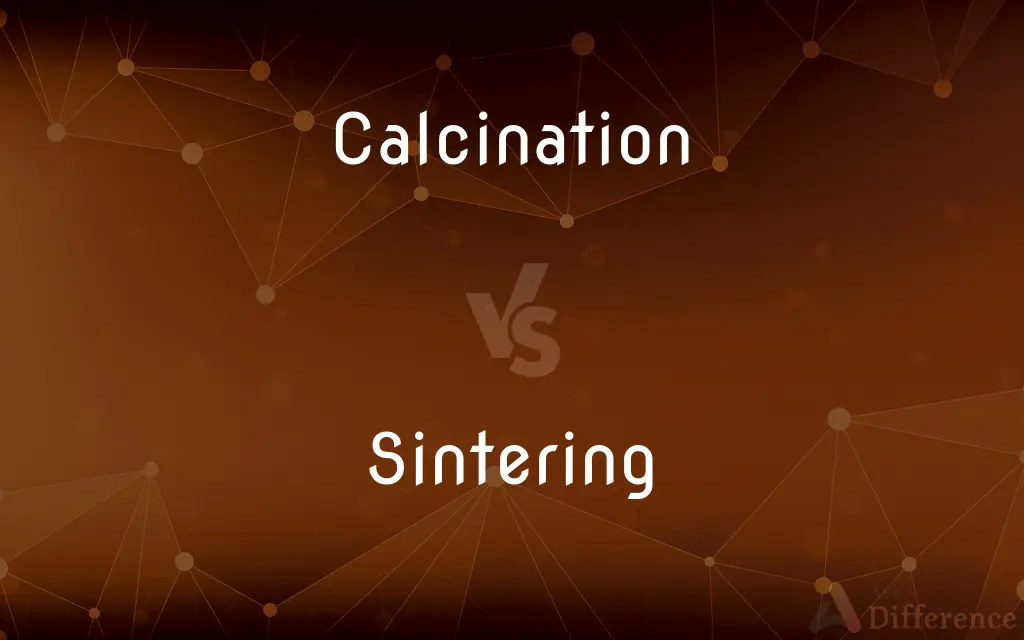Calcination vs. Sintering — What's the Difference?
Edited by Tayyaba Rehman — By Urooj Arif — Updated on April 15, 2024
Calcination involves heating materials to high temperatures in the presence of air or oxygen, primarily to remove volatile substances, whereas sintering involves heating materials below their melting points to fuse particles together.

Difference Between Calcination and Sintering
Table of Contents
ADVERTISEMENT
Key Differences
Calcination is a thermal treatment process that typically involves heating materials like ores or powdered metals in the presence of air or oxygen, aiming to drive off volatile fractions such as water, carbon dioxide, or other gases. This process is often used to decompose carbonate ores and remove organic impurities. Sintering, on the other hand, also uses heat but at temperatures below the materials' melting points. The primary goal is to cause the particles of the material to bond together, enhancing strength, structural integrity, and thermal conductivity.
Calcination results in a change in the chemical composition of the material, often making it more reactive or suitable for further processing. For example, the calcination of limestone produces quicklime, an essential component in cement and steel industries. Sintering primarily affects the physical properties of materials, such as density and porosity, without altering their chemical identity. This process is crucial in the production of ceramic objects and powder metallurgy.
The equipment used for calcination includes rotary kilns, shaft furnaces, and fluidized bed furnaces, which allow for efficient heat transfer and temperature control. Sintering typically requires different types of furnaces, such as blast furnaces, mesh belt furnaces, or even vacuum furnaces, depending on the material and desired properties of the final product.
Calcination processes often require higher temperatures than sintering. Temperatures for calcination can exceed 1000°C, especially for materials like alumina and magnesite. In contrast, sintering temperatures are generally lower to avoid melting, focusing instead on achieving particle fusion at points of contact.
Environmental impacts and energy consumption also differ significantly between these processes. Calcination can release substantial amounts of CO2 and other volatile pollutants, depending on the material being processed. Sintering, while still energy-intensive, typically deals with emissions of particulates from the powders being fused but does not usually involve significant gaseous chemical emissions.
ADVERTISEMENT
Comparison Chart
Purpose
Decomposes materials, removes volatiles
Fuses particles together, enhances material properties
Temperature
Generally above 1000°C
Below melting point of the material
Chemical/Physical Change
Chemical composition changes
Physical properties change
Equipment Used
Rotary kilns, shaft furnaces
Blast furnaces, mesh belt furnaces
Environmental Impact
High due to release of gases like CO2
Lower, mainly particulate emissions
Compare with Definitions
Calcination
Used to decompose carbonate ores.
Calcination of calcium carbonate yields calcium oxide.
Sintering
Involves particle fusion at points of contact.
In sintering, powder particles are heated until they bond at the contact points.
Calcination
A process of heating materials in the presence of air to remove volatiles.
Calcination of gypsum at 150°C produces plaster of Paris.
Sintering
Enhances properties like strength and conductivity.
Sintering improves the electrical conductivity of ceramic materials.
Calcination
Often employed in the production of cement.
Calcination in cement manufacturing involves heating limestone.
Sintering
Essential in powder metallurgy and ceramics.
Sintering is a key process in making ceramic dental implants.
Calcination
Aids in the purification of metals.
Calcination is used to remove impurities from bauxite.
Sintering
Typically performed below the melting point.
Sintering of zirconia occurs well below its melting point.
Calcination
Involves thermal decomposition.
The calcination process thermally decomposes organic materials in ores.
Sintering
A process used to create objects from powders.
Sintering of iron ore fines is used to make stronger pellets.
Calcination
Calcination refers to heating (thermal treatment of) a solid chemical compound (e.g. carbonate ores) to high temperatures in absence or limited supply air or oxygen (O2), generally for the purpose of removing impurities or volatile substances and/or to incur thermal decomposition.The root of the word calcination refers to its most prominent use, which is to remove carbon from limestone through combustion to yield calcium oxide (quicklime).
Sintering
Sintering or frittage is the process of compacting and forming a solid mass of material by heat or pressure without melting it to the point of liquefaction. Sintering happens naturally in mineral deposits or as part of a manufacturing process used with metals, ceramics, plastics, and other materials.
Calcination
To heat (a substance) to a high temperature but below the melting or fusing point, causing loss of moisture or volatile impurities, reduction or oxidation, and the decomposition of carbonates and other compounds.
Sintering
(Geology) A chemical sediment or crust, as of porous silica, deposited by a mineral spring.
Calcination
To convert (liquid material, especially radioactive wastes) to granular solids by drying at very high temperatures.
Sintering
A mass formed by sintering.
Calcination
To be calcined.
Sintering
To cause (metallic powder, for example) to form a coherent mass by heating without melting.
Calcination
A substance produced by calcining.
Sintering
To form a coherent mass by heating without melting.
Calcination
The process of calcining: heating a substance to a high temperature, but below its melting point, to bring about thermal decomposition.
Sintering
Present participle of sinter
Calcination
The act or process of disintegrating a substance, or rendering it friable by the action of heat, esp. by the expulsion of some volatile matter, as when carbonic and acid is expelled from carbonate of calcium in the burning of limestone in order to make lime.
Sintering
A process in which the particles of a powder are welded together by pressure and heating to a temperature below its melting point
Calcination
The act or process of reducing a metal to an oxide or metallic calx; oxidation.
Calcination
The conversion of metals into their oxides as a result of heating to a high temperature
Common Curiosities
Can calcination and sintering be used for the same materials?
While both processes can be applied to a range of materials, their suitability depends on the desired outcome; calcination is typically used for thermal decomposition and removal of impurities, whereas sintering is used for bonding particles and improving material strength.
What are the environmental concerns associated with calcination?
The main environmental concerns include the emission of greenhouse gases like CO2, especially when calcining carbonate ores, and other pollutants depending on the material.
What role does temperature play in sintering?
Temperature in sintering is crucial to achieving the right level of particle bonding without reaching the melting point of the material, thereby enhancing the material’s integrity without altering its fundamental properties.
Why is control of atmosphere important in sintering?
Controlling the atmosphere during sintering prevents oxidation or other unwanted chemical reactions that could weaken the material or alter its properties.
Are there any post-treatment processes required after calcination or sintering?
Post-treatment processes may be required after calcination to stabilize the material or enhance its properties, such as hydration in the case of lime. After sintering, processes like machining or additional heat treatments might be needed to achieve desired specifications.
Can both calcination and sintering be considered environmentally friendly processes?
Both processes are energy-intensive and can have environmental impacts, but advancements such as recycling heat or treating emissions are helping reduce their ecological footprints.
What industries use calcination?
Industries such as cement, ceramics, metallurgy, and chemical processing widely use calcination for material preparation and purification.
How does sintering affect the mechanical properties of materials?
Sintering generally enhances mechanical properties such as strength, durability, and thermal conductivity by bonding material particles more closely together.
How do the costs of calcination and sintering compare?
The costs can vary widely depending on the scale, materials, and specific equipment used, but generally, calcination can be more cost-intensive due to higher energy requirements and emissions control.
What are the latest advancements in calcination technology?
Recent advancements include the development of more efficient kiln designs, use of alternative fuels, and integration of CO2 capture technologies to reduce environmental impact.
What innovations are being made in sintering techniques?
Innovations in sintering include laser sintering and flash sintering, which allow for faster processing times and greater control over material properties.
How is the quality of the final product affected by each process?
In calcination, the quality is affected by factors such as temperature uniformity and time, which influence the complete removal of volatiles and the stability of the chemical structure. In sintering, particle size distribution, temperature, and time impact the density and uniformity of the final product.
What types of materials are typically sintered?
Materials commonly sintered include metals, ceramics, plastics, and composites, each chosen for specific applications in industries like aerospace, automotive, and electronics.
What are some common defects in sintered products?
Common defects in sintered products include porosity, non-uniform grain growth, and structural weaknesses, which can occur due to improper temperature control or particle size distribution.
What safety measures are necessary for calcination?
Safety measures include controlling dust, managing high temperature and pressure conditions, and ensuring proper ventilation to handle potentially toxic fumes.
Share Your Discovery

Previous Comparison
Craw vs. Gullet
Next Comparison
DOS vs. UnixAuthor Spotlight
Written by
Urooj ArifUrooj is a skilled content writer at Ask Difference, known for her exceptional ability to simplify complex topics into engaging and informative content. With a passion for research and a flair for clear, concise writing, she consistently delivers articles that resonate with our diverse audience.
Edited by
Tayyaba RehmanTayyaba Rehman is a distinguished writer, currently serving as a primary contributor to askdifference.com. As a researcher in semantics and etymology, Tayyaba's passion for the complexity of languages and their distinctions has found a perfect home on the platform. Tayyaba delves into the intricacies of language, distinguishing between commonly confused words and phrases, thereby providing clarity for readers worldwide.















































